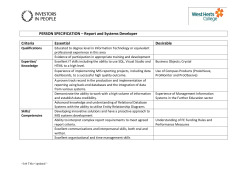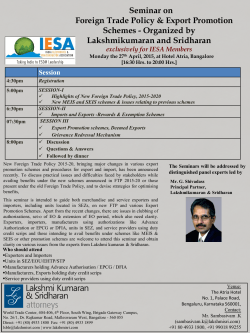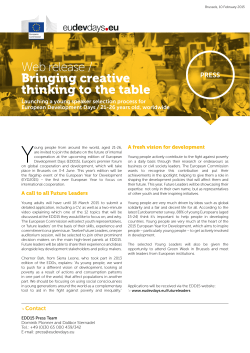
Adequate Minimum Income
Fintan Farrell EMIN Project Manager Committee on Social Affairs, Health and Sustainable Development – Council of Europe Chisinau, Republic of Moldova – 19 May 2015 Content 1. Overview of EMIN Project 2. Setting the scene and Overview of findings in 30 national reports on adequacy, coverage and take-up of MIS 3. EU Road Map for the progressive realisation of Adequate Minimum Income Schemes 4. Conclusions 1) EAPN Work on Minimum Income • Concern since beginning of EAPN contributed to 1992 Council Recommendation • EAPN Irl led Social Standards Project (2007) • 2008 – EAPN pushed for the Active Inclusion Recommendation • Austrian led EU Project Standard Budgets (2009) • EAPN Major Conference (Launch of draft Framework Directive) and Campaign on Adequate Minimum Income (2010) • EAPN Election Campaign 2014 (See Blog electingchampionsin2014.net) • Constant part of EAPN work on Europe 2020 and related activities • EAPN work to build consensuses: • European Parliament: Report on Minimum Income (2010) Platform against Poverty Report (, • Committee of the Regions Report on PaP (2010), • European Economic and Social Committee Report on Minimum Income (2013) • Parliament Semester Report (2015) • 2013 European Meeting of People Experiencing Poverty on Adequate Income (see reports on www.eapn.eu) • EMIN Project 2013-2014 • EAPN committed to coordinate follow up of the EMIN project 1) EMIN Network Aim of the Network • To raise awareness on 1) the commitments made by the Council and Commission on adequate Minimum Income Schemes, 2) the importance of adequate Minimum Income Schemes to keep people active in society 3) the Importance for all of the society of adequate Minimum Income Schemes as the base for a high level social Protection Systems • To build consensus and advocate to take the necessary steps towards the progressive realisation of adequate and accessible minimum income schemes at 1) National and 2) EU levels 1) Based on a Common Understanding Minimum Income schemes: “income support schemes which provide a safety net for those who cannot work or access a decent job and are not eligible for social security payments or whose entitlements have expired” Adequate Minimum Income: income that is indispensable to live a life in dignity and to fully participate in society 1) Partners in the Project – Building stakeholder engagement initiated by the European Parliament and financed by the European Commission Lead Partner: EAPN (European Anti-Poverty Network) Key European level Partners •AGE Platform Europe •FEANTSA (European Federation of National Organisations Working with the Homeless) •Belgian Public Administration, Public Planning Service Social Integration, Anti Poverty Policy and Social Economy Social Integration •ANSA (Agence Nouvelle des Solidarités Actives) •ETUI (European Trade Union Institute) •OSE (Observatoire Social Européen) •SIRG (Social Inclusion Regional Group) National Minimum Income Networks (building engagement of stakeholders) •Belgium by Belgian Anti Poverty Network •Italy, CILAP/EAPN Italy •Ireland, EAPN Ireland •Denmark ,EAPN Denmark •Hungary by EAPN Hungary Year 2: Work in a further 25 Countries 1) Key Outputs • 30 National Conferences and Reports • 2 Thematic Reports Non-take-up amongst vulnerable groups – FEANTSA Adequacy in older age – AGE Platform • Synthesis Report (synthesis of 30 reports plus EU road Map) 1) Adequate incomes throughout the life cycle Important to have distinct work on the topic of adequate and accessible Minimum Income Schemes but must be placed within the wider frame of ‘Adequate Income throughout the life cycle’ and within an Active Inclusion (Adequate Income, Accessible Services and Inclusive Employment) approach Positive Hierarchy between: Minimum Income, Social Protection (Insurance schemes), Wages Essential to defend the media levels (income and wages). We will never have accessible and adequate Minimum Income schemes unless we have a better overall distribution. Important to distinguish concept of Minimum Income from concepts such as: Citizen Income or Basic income 2. Setting the scene: ensure every person’s fundamental right to live a life in dignity People living in poverty in EU since 2009: +10 million. Now over 124 million. ¼ population cannot enjoy their right to live a life in dignity. Current policies fail to deliver on the Europe 2020 target of reducing poverty by at least 20 million by 2020. Little evidence of progress in member states to improve benefits systems and ensure adequacy of benefits. Crisis and austerity measures: Increased conditionality and failure to upgrade benefits. A balanced socio-economic policy with a rights-based approach needed! 2) Setting the scene: ensure every person’s fundamental right to live a life in dignity What we want: binding law on European Social Standards for upward social convergence (instead of race-to-thebottom) and social progress (instead of social dumping). Adequate minimum income schemes in all member states is a corner stone = basis for high quality social protection schemes and positive hierarchy with other social benefits and minimum wages. Minimum Income = income support schemes, safety net for people who cannot work and not eligible for social insurance payments or entitlements have expired 2. National reports on adequacy, coverage and take-up of MIS • All 30 countries, except Italy and Greece have some sort of MIS established at national level, in line with definition of EMIN project • MIS are very different in countries: many countries (AT, BE, BG, CY, CZ, DE, DK, FI, FR, IS, LU, NL, NO, PT, RO) have comprehensive and simple MIS, open to all people with insufficient means; other have simple and non-categorical systems but with restricted eligibility and coverage (EE, HU, IE, LT, NL, SE, SK, UK); some countries have a complex network of more categorical schemes (ES, IE, MT, UK); some countries have limited piecemeal schemes for specific groups in need (BG, RS) • Most MIS have eligibility conditions related to residence, age, lack of resources, willingness to work. • Benefits vary according to household composition; uprating often not on regular basis; means-testing; mostly no time limits 2) National reports on adequacy, coverage and take-up of MIS • Big differences in generosity of benefits, ranging from 22 EUR in BG to 1433 EUR in DK for a single person, and from 100 EUR in PL and 3808 EUR in DK for a couple with 2 children • In relation to median equivalised income: 1. High level (over 50%): only DK and IS 2. Medium-high (40-50%): AT, BE, IE, LU, LT, MK, NL 3. Medium-low (30-40%): CY, DE, ES, FI, FR, MT, NO, PT, UK 4. Low (20-30%): CZ, EE, HU, RO, SE 5. Very low (under 20%): BG, LV, PL, SK • Countries with low and very low generosity are all in Central and Eastern Europe, except Sweden. Ensuring adequate MI will require a lot of effort. • Small proportion of population: most countries less than 5%; some even under 3% 2) Adequacy of MIS: overview of obstacles Little transparency as regards methodology to determine what constitutes sufficient or minimum standard of living, no clear definition of decent income: minimum income set by government decision, proportion to pensions, unemployment benefits, minimum wage. No country (except DK in future 50% during 3 years = persistent poverty) uses AROP indicator Some countries use concepts such as subsistence minimum or level, MI to avoid absolute poverty Some countries use reference budgets to set MI level, but baskets often don’t cover all expenses. In countries with well-conceived reference budgets, these are seldom used as benchmarks for MI Most teams find that MI doesn’t allow people to live in dignity 2. Coverage and take-up of MIS Several team find that their country uses thresholds to qualify for MI that are extremely low. Some teams point to the problem of young people living with parents, who can’t receive MI. Also (undocumented) migrants and homeless people are often cited as having difficulties to access MIS. In some countries coverage is reduced through excessive means-testing Non-take-up: serious problem! From 20% to as much as 75%: figures much higher than fraude, but less policy and media attention! Several reasons for non-take-up: - Unknown rights and lack of communication - Unclaimed rights and offer relevancy, by constraint - Unclaimed rights by ‘choice’ - Unobtained rights and administrative obstacles 3. EU roadmap towards progressive realization of adequate and accessible Minimum Income Schemes 3.1 Awareness raising and public debate 3.2 EU Directive 3.3 Integrate follow up on adequate Minimum Income Schemes in key EU processes 3.1 Awareness raising and public debate: We have the arguments! Adequate Minimum Income: income that is indispensable to live a life in dignity and to fully participate in society Many commitments : European Council (1992 rec), Commission (2008 active inclusion rec), European Parliament (2010 on MI and 2011 on Platform against poverty), European Committee of Regions (2011 on MI), European Economic and Social Committee (2013 on MI and European Fund Solidarity) have committed to ensure adequate minimum income ETUC (2013 social dimension EMU) and Social Platform (2014 position EPSCO) support 3.1 Awareness raising and public debate: We have the arguments! Well-designed, adequate and widely available income support schemes do not discourage a return to the labour market. On the contrary, they give people greater chances to take up a job than non-recipients = good social investment! It is crucial to guarantee adequate income for people in vulnerable situations for whom a return to work is not possible: human right (Treaty EU, Charter) Also economically sound: member states with good social welfare policies are amongst the most competitive and prosperous. 3.1 Awareness raising and public debate: We have the arguments! Ensure that people who need them can remain active in society, and allow them to live in dignity More equal societies = better for the whole of society (Wilkinson, Picketty) ‘Economic stabilizers’: countries with high quality social protection systems are better able to resist negative impacts of the crisis Very small percentage of social spending and have a high return on investment. Cost of non-investment: enormous impacts for individuals, society and economy 3.1 Awareness raising and public debate They are cost effective economic stimulus packages, as the money involved immediately re enters the economy They can play a positive role in reversing the destructive trend of rising numbers of ‘working poor’ in Europe Inadequate Minimum Income Schemes help in addressing very basic needs, however they are likely to lock people in a cycle of dependency without adequate means to access opportunities or to fully participate in society 3.2 EU Directive on adequate MIS – Why? New start and stronger base for action needed. Give meaning to EU committment on combating social exclusion of the Fundamental Rights Charter. No longer viable to develop national social policy without considering the European perspective. Common EU level efforts are needed to help achieve high social standards. Citizens are strongly attached to the European Social Model. Convergence of costs of living is growing withour similar convergence of levels of social benefits and wages a highly divided Europe with loss of solidarity and growing distrust of European institutions. A Directive would show commitment to a Union of social values and would help restore confidence. 3.2 EU Directive on adequate MIS – Content Treaty allows EU to act: art 153, 1, h: people excluded from labour market! Content: What is adequate Minimum Income? at risk of poverty indicator, 60% of median equivalised income and material deprivation indicators, common EU-wide methodology for reference budgets to test the robustness of the level of MI and of the 60% threshold, based on active participation of people experiencing poverty in the establishment of the basket of goods and services 3.2 EU Directive on adequate MIS – Factors to be considered Who is covered? How to ensure better covered and take up? Member States to evaluate their MIS: avoid the creation of hidden poverty, to ensure take up, by reducing conditionality requirements, increasing transparency, informing eligible benefit recipients actively about their rights, by establishing simplified procedures and by putting in place policies to fight stigma and discrimination Uprating? Appeal? Common information requirements, monitoring and evaluation, stakeholder involvement. Active inclusion approach: adequate minimum income, combined with inclusive labour markets and enabling (social) services 3.3 Integrate follow up on adequate MIS in key EU processes - Europe 2020 strategy Adequate MIS will contribute to the delivery of the Europe 2020 poverty reduction target: progress reports, country specific recommendations on adequate minimum income Use 20% of European Social Fund for social inclusion in partnership with NGOs Exchange best practices to find ways to tackle poverty and social exclusion European Commission should use horizontal social clause to assess austerity measures and reforms Develop a system of well-defined and binding EU level social standards in hard law, as part of a Social Pact for Europe: adequate Minimum Income as pioneer. 4. Conclusion: a story that millions of Europeans would want to hear Many existing commitments on adequate and accessible Minimum Income Schemes at EU level Not something new: common effort to ensure high quality scheme in all EU Member States Feasible to introduce a Directive on the Adequacy of Minimum Income Schemes under EU treaties Good arguments why this would be good for the people, for the society in general and for the EU EU citizens would want to know what Member States and other EU political leaders are doing to introduce or to block such a development and to explain their approach The EMIN project is an exciting opportunity to contribute to this ‘story’ Key Developments Nordic Countries: Shift from ‘subsidiarity position’ to a recognition that the absence of a common EU effort is putting pressure on Nordic welfare model For some Central and Eastern European Countries: Greater understanding of the links between minimum income, access to employment and the role of services. Adequate Minimum Income Schemes seems less utopian and more achievable Italy: Facilitated a coming together of diverse groups working on related themes and initiatives In General: Greater awareness that EU can’t develop socially and can't speak of solidarity with such divergence EMIN Contacts For more information contact Fintan Farrell, Project Manager fintan.farrell@eapn.eu Anne Van Lancker, Project Policy Coordinator vanlanckeranne@gmail.com To follow the project emin-eu.net Twitter #eminetwork
© Copyright 2025









